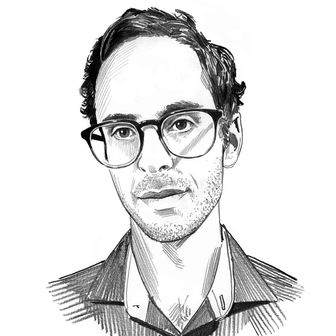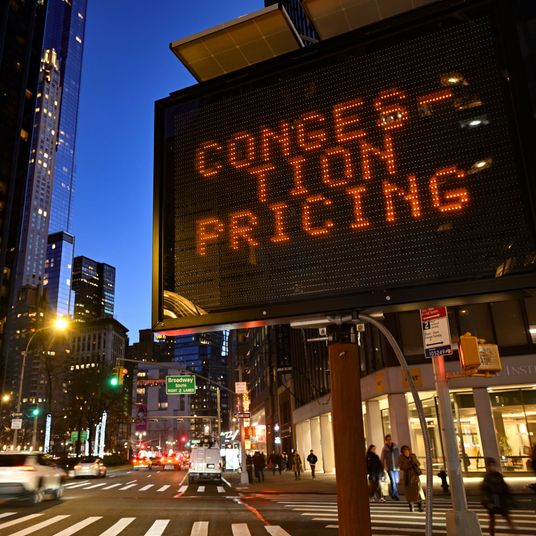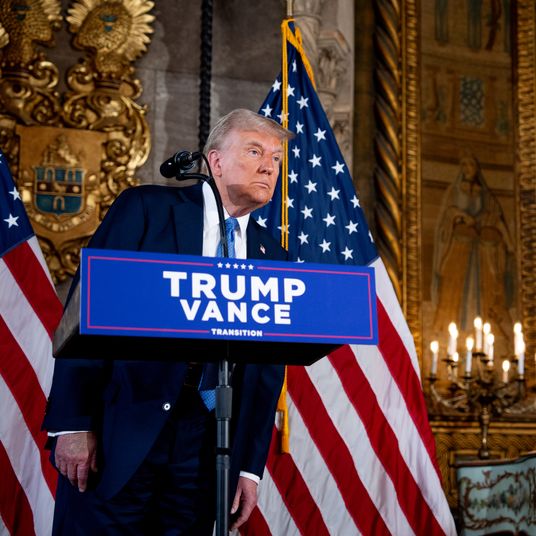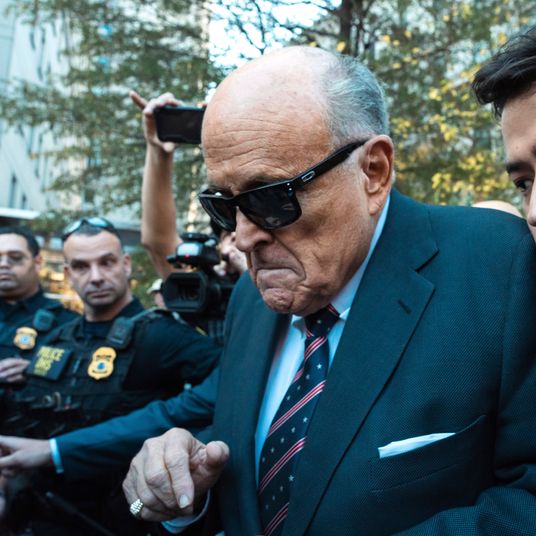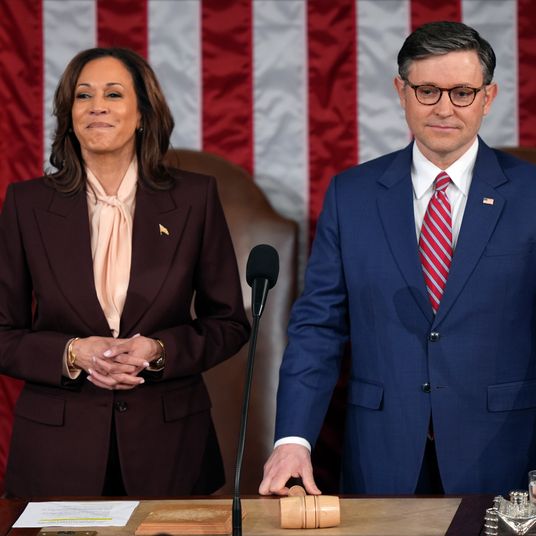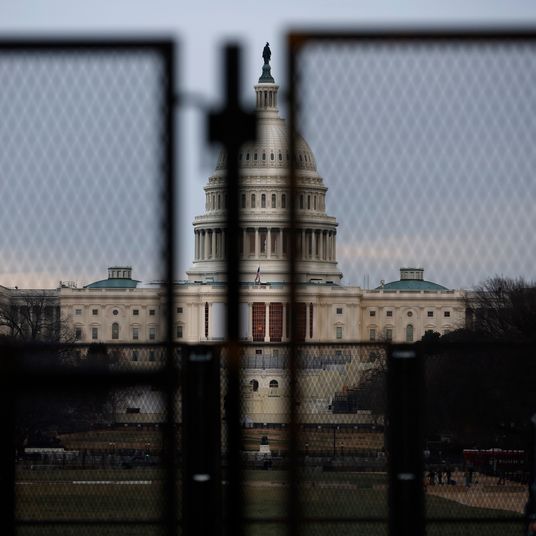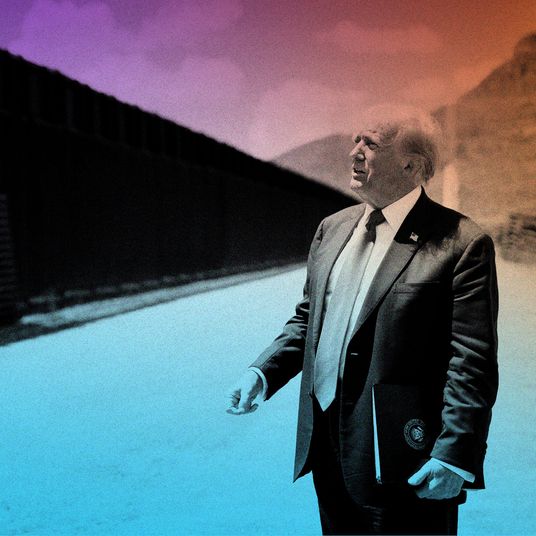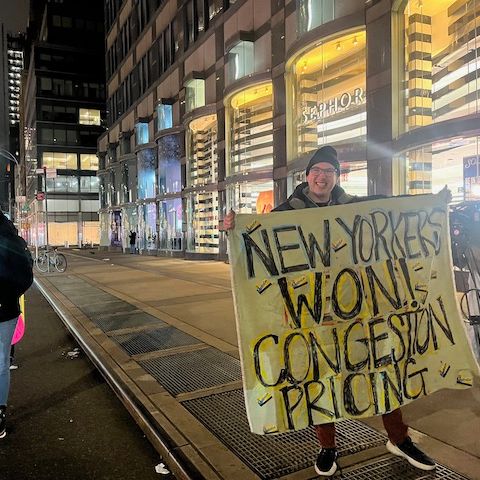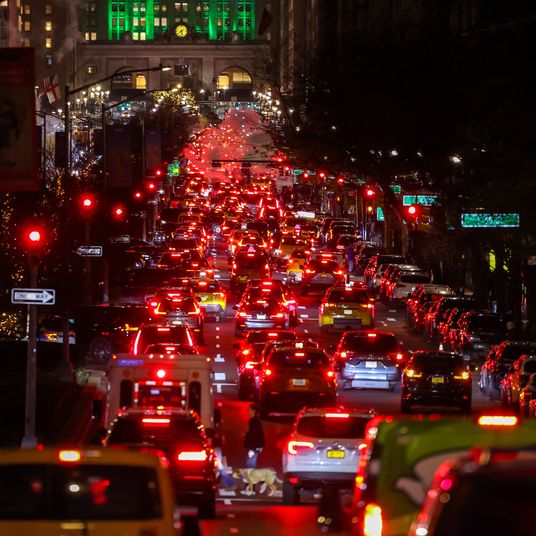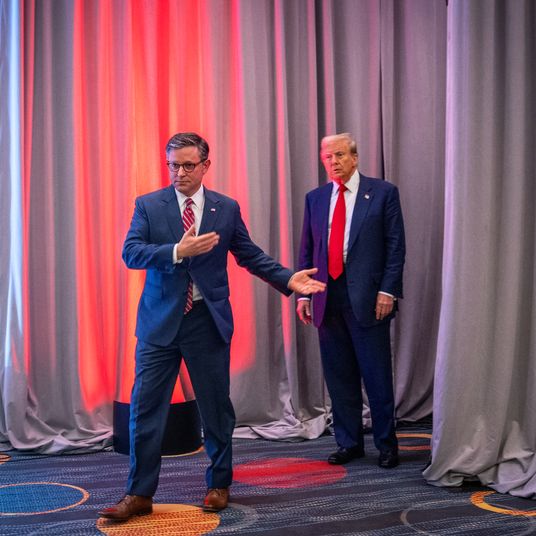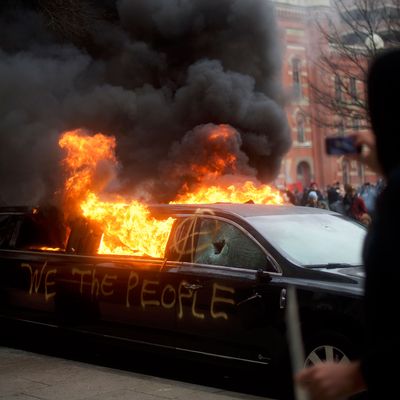
American democracy is unwell; on this much, President Trump’s detractors can agree.
But when they turn to the tasks of identifying our republic’s symptoms, naming its illness, and writing a prescription, different factions of “the resistance” produce divergent diagnoses.
One group — comprised of comparative politics scholars, liberal pundits, and NeverTrump conservatives — have their eyes fixed on Donald Trump. They see the moral cowardice of a Republican elite that declined to deny an illiberal demagogue their nomination, or to abandon him in the general election, or to let the investigation into his campaign proceed unimpeded. They observe a president who relentlessly assails the independence of federal law enforcement, the legitimacy of adversarial media, and the veracity of official election results — and a conservative base that takes his lies to be self-evident. And, pulsing beneath it all, they discern the rise of a hyperpartisanship that’s leading each party’s elected officials to eviscerate informal constraints on their authority — and each party’s voters, to believe that the other side has no legitimate claim to power.
In these complaints, the democracy movement (as my colleague Jonathan Chait has dubbed it) sees all the telltale signs of a bad case of norm-erosion. Democracies can’t live on laws alone; they also require adherence to certain informal rules that correct for the inevitable flaws in any Constitution’s design, and protect against the threat of charismatic leaders consolidating power. Thus, to heal our republic, and immunize it against future strains of the same virus, several liberal thinkers have called for the formation of bipartisan coalitions, united in defense of democratic norms and the rule of law. In their view, the threat that Trump poses is so grave and unique, ideologues on both sides of the aisle should now prioritize maintaining a rule-based order over winning policy battles, so as to safeguard their freedom to settle such disputes democratically in the future.
But there is a second opinion.
Several social democratic (and/or, democratic socialist) thinkers, examining the patient from a few steps to the democracy movement’s left, have had their eyes drawn to a different set of symptoms. They see state and federal legislators who routinely slash taxes on the wealthy, and services for the poor, in defiance of their constituents’ wishes; regulatory agencies that serve as training grounds for the firms they’re meant to police; a Supreme Court that’s forever expanding the rights of corporations, and restricting those of organized labor; a criminal-justice system that won’t prosecute bankers for laundering drug money, but will dole out life sentences to small-time crack dealers; a central bank that has the resources to bail out financial firms, but not the homeowners whom they exploit; a Pentagon that can wage multitrillion-dollar wars that exacerbate the very problems they were supposed to solve — and still get rewarded with a higher budget — even as the Housing Department asks the working poor to pay higher rent for worse accommodations; and, seething beneath all of these defects, disparities in the distribution of private wealth so vast and consequential, the nation’s super-rich have come to enjoy an average life expectancy 15 years longer than its poor.
In these grisly conditions, social democrats see a textbook case of malignant capitalism. Democracies cannot survive on norms alone. When markets are left under-regulated — and workers, unorganized — the corporate sector becomes a cancerous growth, expanding until it dominates politics and civil society. An ever-greater share of economic gains concentrates in ever-fewer hands, while the barriers to converting private wealth into public power grow fewer and farther between. Politicians become unresponsive to popular preferences and needs. Voters lose faith in elections — and then, a strongman steps forward to say that he, alone, can fix it.
All this contraindicates the democracy movement’s prescription: If our republic’s true sickness is its inegalitarian economic system, then that illness won’t be cured by cross-ideological coalitions. Quite the contrary: What’s needed is a movement that mobilizes working people in numbers large enough to demand a new deal from capital. Thus, if the liberal intelligentsia wishes to save American democracy, it should devote the lion’s share of its energies to brainstorming how such a movement can be brought into being — and what changes that movement should make to our nation’s political economy, once it takes power.
Why this argument matters.
It’s important not to exaggerate the division between “normcore” liberals and “radical” leftists. Jedediah Purdy, the Duke University law professor who wrote a much-discussed critique of the former, has condemned Trump’s (norm-defying) lies about voter fraud as a dire threat to “self-rule” in the United States. Steven Levitsky and Daniel Ziblatt, whose book How Democracies Die is the bible of the “normie” center, argue in that very text that “addressing economic inequality” could help inoculate America against future populist demagogues. Each side recognizes that both our economic system’s tendency to concentrate wealth at the top and Trump’s assault on democratic norms are serious problems; they just disagree about which of these represents the more fundamental threat to American democracy at the present moment.
But there are real stakes to that dispute. Beyond the aforementioned implications for how the anti-Trump opposition should be organized, the goal of preserving norms, and that of redistributing economic power, can — and, if Democrats ever regain power, will — come into conflict.
Let’s say Chuck Schumer becomes Senate Majority Leader next year. If restoring norms is the paramount objective, then he will have to implore his caucus to confirm any conventionally qualified judicial nominees that the president puts forward; if combating runaway corporate power is the first priority, however, he’ll need to have those nominations killed in committee, to keep seats open for future, pro-labor judges. Similarly, if Democrats secure full control in 2020 (or 2024, or 2028), abolishing the filibuster will almost certainly be a prerequisite for any major redistributive reform. And if Trump is able to appoint multiple Supreme Court justices — and a “neo-Lochner era” commences, with the court’s far-right majority routinely vetoing landmark progressive legislation (as it came within one vote of doing to the Affordable Care Act) — then it will be very important for progressives to know whether norm-erosion or economic inequality is the more fundamental threat to their democracy.
What the left gets right.
In his critique of the democracy movement’s leading thinkers, Jedediah Purdy argues that their various analyses of America’s political crisis share a fundamental defect: They all fail to ask whether the version of capitalism that emerged in the United States in the wake of the stagflation crisis of the late 1970s — a capitalism characterized by, among other things, weak labor unions, corporate concentration, low growth, and high inequality — is “compatible with democracy.”
Purdy suggests that it is not. And he’s right.
There are two distinct arguments for this position. First, there is the hypothesis that the failures of capitalism are largely responsible for the rising popularity of illiberal populism throughout the West, and thus, that reforming our economic system is the best way to shield fundamental democratic norms from future assaults.
Many object to this argument by pointing to the abundant evidence that Trump’s support was rooted in racial and cultural reaction, not “economic anxiety.” And it is difficult to argue that America’s relatively high levels of immigration — and eroding racial and gender hierarchies — would not have inspired some amount of reactionary backlash, even in the best of economic circumstances. But this objection is not dispositive. For one thing, there is both historical and social scientific evidence that in times of economic uncertainty, people become more inclined toward the kinds of cultural resentments that Trump exploited and cultivated. When human beings feel that the basis of their self-esteem and social status is under threat — as is often the case for downwardly mobile workers in deindustrializing regions — they tend to grow increasingly wary of diversity, more open to extremist ideas, and more defensive of the status of the social identity groups to which they belong.
More critically, the claim that our current crisis has economic roots does not rest on psychoanalyzing the Trumpen proletariat. In the four decades since the stagflation crisis — which inaugurated a sharp right turn in the politics and economics of Western democracies — American workers’ share of productivity gains plummeted; the nation’s private-sector unionization rate collapsed; the gap between the wealth of rich and poor households exploded; and the middle class became reliant on an ever-higher levels of debt to finance their homes, automobiles, and children’s educations.
And over that very same period, social trust, civic engagement, voter participation, and confidence in public institutions all fell significantly in the United States. There is cause for seeing these latter developments as products of the former ones: In the years before Trump’s election, polls routinely found supermajorities of the American public saying that their nation’s economy was “rigged” against them. In November 2015, a Public Religion Research Institute (PRRI) survey found 64 percent of Americans agreeing with the statement, my “vote does not matter because of the influence that wealthy individuals and big corporations have on the electoral process.” One year later, 75 percent of voters who cast early ballots in the 2016 election told Reuters/Ipsos that they were looking for a “strong leader who can take the country back from the rich and powerful.”
Whatever was in the hearts of marginal Trump voters, a nation where most citizens believe elections don’t matter because the powerful control politics is one ripe for authoritarian populism.
And America isn’t the only nation that has seen a increase in both inequality — and distrust in democracy — since the late 1970s. That trend is common to most of Western Europe, where it has also coincided with rising support for illiberal and extremist political parties. As Caleb Crain notes in The New Yorker, the period of high growth, and relatively equitable distribution of productivity gains that prevailed in the postwar era fostered a distinctly different political climate: In three decades after the Second World War, no populist politician (defined as “anti-elite, authoritarian, and nativist”) came to power in any advanced Western nation, while a “far narrower share of votes went to extremist parties than before or after.”
There is considerable evidence then, that a more equitable distribution of economic power would reduce popular support for extremist politicians and parties in the United States. It is unfortunate that America elected an illiberal demagogue in 2016 — but quite fortuitous that he happened to be a singularly unpopular, incompetent, and lazy one; if we don’t take action to ameliorate the conditions that produced his presidency, we may prove less lucky the next time around.
The second (and, in my view, more bulletproof) argument for Purdy’s indictment of contemporary capitalism isn’t rooted in speculative claims about our democracy’s future, but in a critical assessment of its past. Put simply: Making America “already great” again is not enough to make our nation truly democratic. Even if American-style capitalism weren’t a threat to our current political order’s survival, it would remain an insurmountable obstacle to providing millions and millions of U.S. citizens with the right to genuinely participate in their own government.
In President Obama’s United States, corporations and wealthy individuals invested record amounts of money in influencing American politics; the policy preferences of the economic elite routinely overruled those of ordinary Americans; nearly 6 million U.S. citizens were disenfranchised for having once committed a federal crime; and the nation’s (always aberrantly low) voter turnout rate hit a 70-year low in 2014’s midterm elections.
Not all of these obstacles to popular sovereignty are rooted exclusively in economics. But the most formidable and consequential are.
One doesn’t need to believe that capitalism, as such, is incompatible with democracy to accept that a certain threshold of economic equality is a prerequisite for the latter. In fact, it is doubtful that any genuine supporter of democracy believes that no such threshold exists.
Imagine a United States in which 99.9 percent of citizens had to labor 70 hours a week just to keep their families housed and fed (and then, just barely). Imagine that those citizens rarely knew exactly what their work schedules would be, and thus, had to constantly renegotiate child-care arrangements — and that all this put an enormous strain on their mental health and personal relations, leaving them bereft of the time and energy necessary to keep up with the news, or join community organizations, or attend town hall meetings, or cast a ballot in the middle of a Tuesday.
Would you say that the economic system of such a nation was compatible with democracy?
If not, then how is a system that condemns a smaller — but still substantial — percentage of the demos to such conditions compatible with it?
Why the democracy movement can’t be nonideological.
Now, one could accept all the left’s claims about contemporary capitalism’s incompatibility with democracy, and still see Trump’s assault on democratic norms as the more pressing threat to our republic. After all, some norms really are more fundamental to liberal democracy than any policy on a social democrat’s wish list: Prohibitions against elected officials disputing the integrity of election results, encouraging political violence, or directing law enforcement to police dissent are more indispensable to self-rule than labor-law reform or universal health care (without such prohibitions, reactionary forces will have little trouble rolling back such left-wing reforms, anyway).
But it does not follow from this point that champions of democracy should concentrate their energies on defending the former, rather than organizing for the latter. The democracy movement’s prescription may be the proper one for a moment of acute democratic crisis.
This reality is reflected in the Democratic Party’s midterm strategy. Democratic candidates seeking election in contested House districts are talking far more about the GOP’s assault on Medicaid, than Donald Trump’s attacks on Robert Mueller. The Democratic Congressional Campaign Committee is no socialist vanguard; it is not instructing its candidates to focus their fire on economic injustice — instead of norm violations — because it wishes to lay the foundations for a movement that can challenge capitalism. It is doing so because it wants Democrats to win control of the House. Thus, whether one’s primary objective is to safeguard our constitutional order against Trump in the near term — or to make our economic system more compatible with democracy in the long run — the left’s organizing strategy remains more viable: An opposition movement centered on a a call for progressive economic change is bound to be more formidable than one based on a nonideological commitment to procedural norms.
This settles one dispute between the “normcore” center and “radical” left. But it doesn’t resolve their most profound point of contention: what to do when a genuinely important democratic norm becomes an insurmountable obstacle to progressive economic reform.
The hard case of the “neo-Lochner scenario.”
This is not a wild hypothetical, but a circumstance we encountered the last time the failures of our economic system provoked widespread doubts about the sustainability of liberal democracy.
Franklin Roosevelt took office at a time of unprecedented economic depression, when the apparent impotence of liberal democracies to restore prosperity was propelling fascist (and illiberal populist) political movements to unprecedented prominence — if not outright power. In the view of many contemporary observers, radical changes in the structure of America’s political economy were not just necessary to improve social welfare or increase democratic participation, but to avert a descent into authoritarian rule.
Roosevelt set about enacting such reforms — some vital and liberatory, others ill-advised and counterproductive. But the mere fact that America’s political institutions were mounting a response as unprecedented and far-reaching as the crisis itself helped to restore a degree of confidence in the viability of the liberal democratic model. In 1936, American voters rewarded Roosevelt with the largest share of the popular vote that any presidential candidate had received in more than a century.
But the Supreme Court was less impressed with FDR’s performance. In 1935 and 1936, the court struck down duly enacted laws with a frequency unparalleled in its history. At a time when the survival of our democracy appeared to require the construction of a new economic order, a discredited and defeated conservative Establishment was using its residual power within the judiciary to thwart progressive change. The president decided that abnormal times called for abnormal measures.
In their book, Levitsky and Ziblatt frame Roosevelt’s “court-packing” scheme as a dangerous assault on the vital norm of an apolitical judiciary — and cast the bipartisan opposition to his plan as an affirmation of our nation’s liberal democratic ideals. And their aversion to court-packing has much to recommend it. The norm that Roosevelt attempted to violate is an important safeguard against democratic collapse: If a unified illiberal government could customize its Supreme Court, that regime could ostensibly revoke the civil rights of vulnerable minority groups, and implement voting restrictions that consolidated their grip on power.
But Levitsky and Ziblatt’s analysis begs a pair of urgent questions: Does a nation where five unelected judges routinely veto popular, duly enacted laws — that are aimed at redistributing economic power in a time of mass unemployment and malnutrition — still have a democracy left to lose? And if it does — which is to say, if “democracy” doesn’t require giving ordinary people a say over how their society’s resources will be distributed, and its markets organized — then how long can one reasonably expect a materially deprived populace to retain reverence for democracy?
The authors gesture to these tensions at points, but they never address them directly. Levitsky and Ziblatt don’t make an explicit case for why maintaining a nine-member Supreme Court was more important than preserving the Second New Deal. Instead, they suggest that responsible elites spared America that hard choice, by putting the preservation of norms above ideological conviction:
It is worth noting that the Supreme Court itself played a major role in defeating Roosevelt’s plan. In a move that has been described as a “masterly retreat” to preserve the Supreme Court’s integrity, the previously anti-New Deal Court quickly reversed itself on a series of decisions … including the National Labor Relations Act and Roosevelt’s Social Security legislation. With the New Deal program on more secure constitutional ground, liberal Democrats in Congress could more easily oppose the president’s Court plan.
And yet, what the authors celebrate in this passage is ostensibly the very politicization of the judiciary that they set out to condemn. In fact, if you cock your head to the left, their account starts to look like a testament to the virtues of prioritizing economic justice over norm-preservation: A “populist” president mounted a frontal assault on the judiciary’s independence; the Supreme Court responded by changing its jurisprudence to fit his demands; and America went on to save the liberal democratic model of government from the gravest challenges it has ever faced.
To be sure, the cause of Justice Owen Roberts’s jurisprudential shift is disputed; the political backlash to the court-packing proposal arguably hindered the passage of other reforms; and, although there was no way of knowing it at time, retirements and reelections ultimately allowed Roosevelt to appoint a pro–New Deal court by ordinary means. My aim in highlighting the tensions in Levitsky and Ziblatt’s account is not to say that the correct response to a neo-Lochner scenario is obvious. It’s to say the opposite: The downside risks of undermining judicial independence are considerable; but so are those of allowing a reactionary Supreme Court to thwart progressive economic change (a future Democratic government may be spared a global depression, but it will be confronted with a global ecological crisis that can’t be effectively addressed absent redistributive and regulatory reforms that Neil Gorsuch won’t like).
There may be a persuasive argument against violating fundamental liberal norms, even in such circumstances. But if center-left thinkers wish to make it, they are going to have to reckon with the insights of their radical critics — and the myriad ways that America’s present economic order is incompatible with how democracies thrive.


